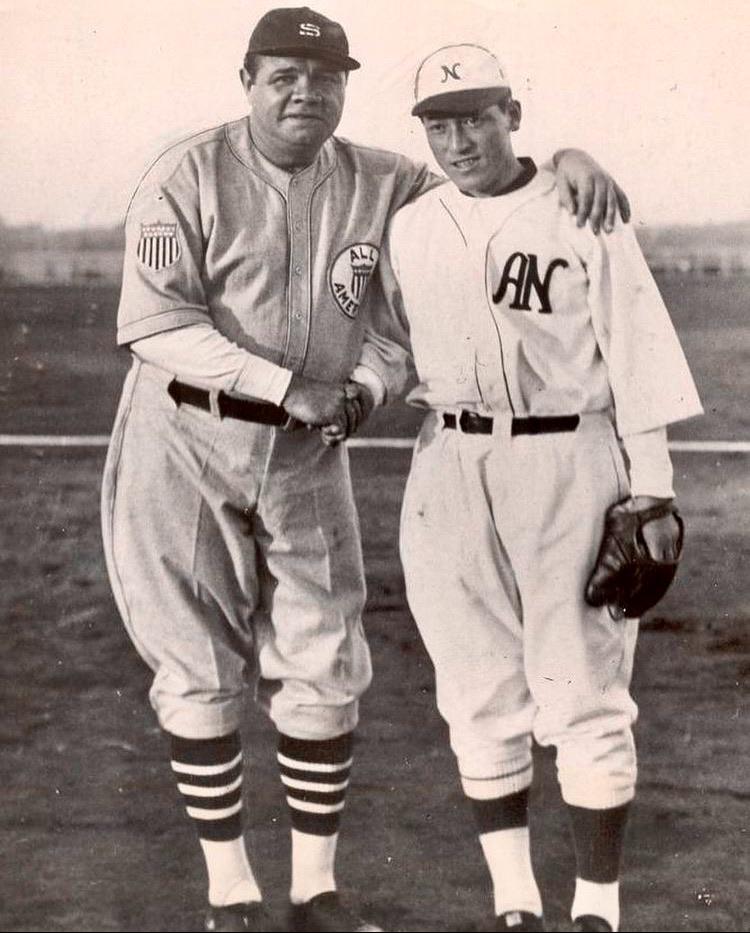Scroll Down to Read Today’s Essay
Subscribe to Baseball History Comes Alive for automatic updates (sign-up block found in right side-bar)
As a Free Bonus for subscribing, you’ll get instant access to my two Special Reports: Memorable World Series Moments and Gary’s Handy Dandy World Series Reference Guide!
Eiji Sawamura and Babe Ruth’s 1934 Tour of Japan Photo Gallery
Click on any image below to see photos in full size and to start Photo Gallery:
Eiji Sawamura and Babe Ruth’s 1934 Tour of Japan
It’s amazing what you discover when searching the National Pastime “This Day in Baseball History” website!
I recently learned that on December 2, 1944, Japan was mourning the death of star pitcher, Eiji Sawamura, who was lost in action when the USS Sea Devil torpedoed his ship off the coast of Yakushima towards the end of World War II. The pitcher had become one of the many causalities of the war, but I wondered why this merited a mention on the National Pastime website.
Reading further, I also learned that Sawamura had become a national hero ten years earlier, on November 20, 1934, while pitching for the Yomiuri Giants. As a 17-year-old high schooler, he was on the mound that day pitching against a touring troupe of American All-Stars. The entourage from across the ocean included quite a few American heavyweights, including some of the game’s biggest names. Check out this roster:
Future Hall-of-Famers Babe Ruth, Lou Gehrig, Jimmie Foxx, Charlie Gehringer, Lefty O’Doul, and Earl Averill. Less recognizable names included Earl Whitehill, Eric McNair, Frankie Hayes, Bing Miller, Joe Cascarella, “Rabbit” Warstler, and spy Moe Berg.
(Correction: the featured photo shows the Babe with Masao Date)
Sawamura had entered the game in the fourth inning and held the American All-Stars to just one run over five innings, striking out nine. The lone tally was a home run by Gehrig in the seventh. It sounded like a nice performance, but was it really worth recalling an exhibition game played 77 years earlier in Japan? There had to be more to the story…
Sawamura Sets the Japanese Baseball World on Fire!
I then discovered what had propelled the young hurler to stardom that day. He had struck out in succession Charlie Gehringer, Babe Ruth, Lou Gehrig, and Jimmie Foxx. The feat was reminiscent of Carl Hubbell’s masterpiece in the 1934 All-Star game played just four months earlier. You’ll remember he struck out, also in succession, Babe Ruth, Lou Gehrig, Jimmie Foxx, Al Simmons, and Joe Cronin.
Lost in the excitement of the moment was that Sawamura and the Yomiuri Giants lost the game, but it hardly mattered. What was really noteworthy—and what set the Japanese baseball world on fire—was the remarkable performance of the young hurler. Overnight, he became a national sensation. It was said Connie Mack was so impressed by Sawamura’s performance he actually tried to sign him to a major league contract on the spot.
Eiji Sawamura’s Career
Sawamura had joined the Yomiuri Giants in 1936 and shortly became one of their aces. He pitched the first no-hitter in Japanese professional baseball on September 25, 1936, and added two others (May 1, 1937, and July 6, 1940). In 1937, he went 33-10 with a 1.38 ERA. From 1937 to 1943, Sawamura posted a career record of 63-22, with 554 strikeouts and a 1.74 ERA. He was a four-time Japanese Baseball champion, triple crown winner (1937), and MVP (1937). His number 14 has been retired by the Yomiuri Giants. Sawamura has been inducted into the Japanese Baseball Hall of Fame, The Sawamura Award, Japan’s equivalent to the Cy Young Award, is named in his honor.
A Few Words About the 1934 Tour of Japan
(Edited from my earlier posts)
There had been other previous tours to Japan, but the 1934 tour was by far the most successful. The reason is actually quite simple: This one included the great Bambino himself, Babe Ruth, who, at the time, was hugely popular in Japan. The excitement level had to be off-the-charts for the barnstorming party as they set sail heading west for the Orient aboard the Empress of Japan. The world’s number one, larger-than-life international celebrity was safely in tow aboard the ship.
And what a reception the American “ambassadors of goodwill” received! It was reported that over 500,000 Japanese lined the streets of Tokyo for the welcoming parade, all hoping to catch a glimpse of the great Bambino. Try to picture the
Eighteen games were played on the barnstorming tour, and the All-Americans, as they were billed, won every game against some of the top Japanese players of the day. Each game was played in front of tens of thousands of fans, all hoping to see the 39-year-old Ruth blast a homer. Always the showman, the Babe didn’t disappoint and lived up to the billing, connecting for 13 round-trippers.
Babe’s daughter Julia later recalled how popular her dad was during the games, as the delirious crowd of Japanese fans would stand and stomp their feet every time he came to bat and roar, “Beibu Rusu! Beibu Rusu!”
The tour was a huge success and helped establish professional baseball in Japan, with the presence of Babe Ruth being a key factor. Could there have been a better worldwide ambassador for baseball in the 1930s than the great Sultan of Swat, Babe Ruth?
Gary Livacari
Subscribe to our website, “Baseball History Comes Alive!” with over 1200 fully categorized baseball essays and photo galleries, now surpassing the 700K hits mark at 740K hits: www.baseballhistorycomesalive.com
Information: Excerpts edited from the Eiji Sawamura Wikipedia page

